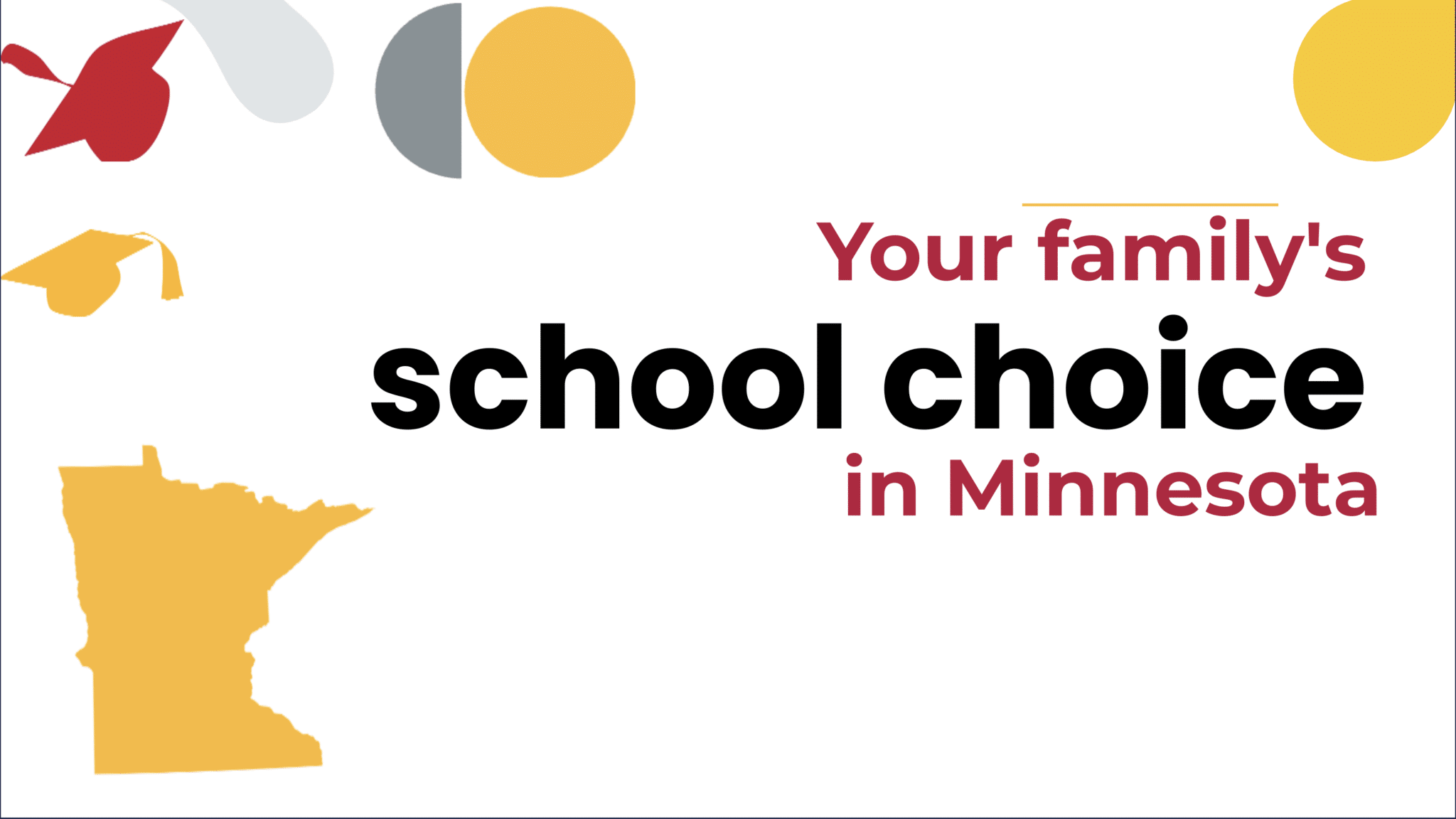Choosing a school? You’ve got options.
If you’re wondering about school choice in Minnesota, here are two things to remember. First off, you’re not alone. Every year, tens of thousands of parents in Minnesota make K-12 school decisions for their children. Secondly, you can do it! Understanding your state’s different school choices can help you find a learning environment where your child is not just “getting by” at school, but actually thriving and inspired to learn.
In short, you can choose from traditional public schools, public charter schools, public magnet schools, private schools, online learning, homeschooling, and microschooling and mix-and-match learning.
Looking for special education options? You can learn what special education services are available in Minnesota at the Ultimate Guide to Special Education.

- Traditional Public Schools
- Public Charter Schools
- Public Magnet Schools
- Private Schools
- Online Schools
- Homeschool
- Microschooling
Minnesota Traditional Public Schools
Most Minnesota (78.3%) students attend traditional public schools. Traditional public schools are free to attend. They are open to all students, operated by school districts, and funded by taxpayers like federal, state, and local government. Did you know that Minnesota spends an average of $14,378 per public school student each year? You can search your school’s spending and that of nearby schools at Project Nickel.
Public school open enrollment refers to whether a parent can choose to send their child to a public school other than their assigned district school. In Minnesota, parents can choose a traditional public school that is outside of their district based on the state’s open enrollment laws, and may be able to choose another school within their district, depending on their local school board. In the 2020-2021 school year, about 10% of Minnesota students used open enrollment!
Since no two public schools are exactly the same, open enrollment can valuably extend a family’s educational options and help them find the best match for their child. If you are interested in this choice, note that transfer applications are usually due by mid-January for the following fall. In most transfers to schools in a different district, the receiving school district provides transportation once the student is within the district border, and can reimburse income-eligible students for their travel there. Minnesota districts are not permitted to charge tuition for transfer students.
Find out more about public schools and transfers in your state at the Minnesota Department of Education or “Public Schools Without Boundaries: A 50-State Ranking.”
Minnesota Charter Schools
You can also consider charter schools. In Minnesota there are about 250 charter schools serving 65,000 children. That’s about 7.1% of the K-12 student population. The majority of charter schools are located in the greater Twin Cities metro area, but there are charters across the state.
Like traditional public schools, charter schools are public, free, and usually have no requirements for entry. What distinguishes charter schools is that they have extra freedom to innovate with learning methods and are accountable to authorizing bodies for results.
Each school has a charter which explains the school’s purpose and what specific community need it serves. For example, that could be providing a Spanish immersion program or offering a rigorous STEAM curriculum. One of the state’s newest charters, Surad Academy in the immigrant town of Faribault, is modeled after a highly successful school in Africa. If there are more families seeking admittance to a charter school than there are seats, a lottery system (like drawing random names out of a hat!) is usually used to determine admittance.
For instance, one charter school executive director we talked to told us about the Core Knowledge curriculum that is part of her school’s charter. “A Core Knowledge school gives kids information through oral telling, through experience, and we add on to their knowledge all the time,” described Lynn Peterson of Cologne Academy.
Learn more about Minnesota charter schools at the MN Association of Charter Schools.
Minnesota Magnet Schools
Magnet schools are free public schools that allow kids to narrow in on a specific learning track, such as engineering or the performing arts. At a magnet school, all the subjects are taught through the lenses of that specific track. So, these might be a good option if there’s one near you with a theme that interests your child.
Minnesota has more than 75 magnet schools throughout the state serving about 7.1% of the K-12 student population. For example, some of the districts with magnet schools or programs include Anoka-Hennepin School District #11, Brooklyn Center Community Schools, Buffalo-Hanover-Montrose Schools, District 196: Rosemount-Apple Valley-Eagan, Independent School District 197, Minneapolis Public Schools, Northwest Suburban Integration District, and Osseo Area Schools ISD 279.
One example of Minnesota’s magnet school offerings is American Indian Magnet School in St. Paul, which provides learning rooted in American Indian culture and history. Meanwhile, Salk Middle School in Elk River has a pre-engineering STEM focus, and was recently recognized as a National Magnet School of Excellence. Plus, a brand new Minnesota magnet school this year is East African Magnet School, an elementary school focused on East African cultures and languages.
Minnesota Private Schools
You can also choose private school! Minnesota families can choose the unique environment of a private school, which may pass on a religious tradition, use a specific curriculum, or offer a smaller classroom environment.
There are more than 600 private schools across the state of Minnesota serving 8.1% of the K-12 student population. The average tuition for private schools in the state is $7,181 for elementary schools and $13,360 for high schools.
While private schools do charge tuition, Minnesota parents are eligible for tax deductions on educational expenses, including private school tuition payments. Minnesota has an additional K-12 Education Credit program that families under a certain income may be eligible to apply for.
Learn more at the Minnesota Independent School Forum, the Minnesota Catholic Conference, and Private School Review: Minnesota.
Minnesota Online Learning
Whether your child wants to accelerate learning or needs a quieter environment, you may be interested in trying virtual school. Minnesota has more online options than most states! Any student who lives in Minnesota, even if they have permanent residency elsewhere, can attend a full-time online school free of charge. For instance, students in any grade can do this through Minnesota Connections Academy (a charter school program and the largest online public school in the state), Minnesota Virtual Academy (which serves about 1,800 students across the state), 196Online, 279Online, SoWashCo Online, Tonka Online, Eden Prairie Online, Saint Paul Public Schools Online, New Code Academy, One91 Virtual Academy, 5Rivers Online, Edina Virtual Pathway, or Minnesota Public Schools Online. Some of these statewide options are charter schools, while some are district-run schools that accept out-of-district students. For a full list of statewide options serving all grades, see the Department of Education’s website.
Besides online schools serving all grades, there are additional online options for students in specific grades. For example, students in grades K-8 can choose Cologne Academy Online, a public charter school with a Core Knowledge focus. Another option is Insight School of Minnesota, which specializes in helping struggling students in grades 6-12 catch up and achieve academic success. IQ Academy of Minnesota also serves students in grades 6-12. Keep in mind that, in order for the funding to follow a student who switches to online school, the family must fill out a Statewide Enrollment Options form.
Finally, free part-time online options are available for students enrolled in public schools (including charter schools), and paid part-time options are available for nonpublic school students.
To read more about online learning in Minnesota, check out the Digital Learning Collaborative’s state profile.
Minnesota Homeschooling
Homeschooling is another school option; this is a great option if you are looking for a hands-on, highly-customizable approach to your child’s education. Homeschooling is the process of parents educating students at home and is permitted in all 50 states.
In Minnesota, 2.8% of all K-12 students are homeschooled. notice of your intent to homeschool is required by October 1 or within 15 days of withdrawing. It is required that you formally withdraw from your public school. In the case that you decide to return to public school, the school will place your student based on evaluation of their records.
The state requires homeschooling families to teach specific subjects (like reading, writing, math, and science) and also requires some level of assessment of students. In some cases, Minnesota homeschoolers may still be eligible to participate in sports or activities at local public schools.
Minnesota offers some funding assistance through a tax deduction program to help with costs related to instruction, field trips, and parental time. To learn more about homeschooling, you may also be interested in checking out the Minnesota Homeschoolers’ Alliance, Home School Legal Defense Association – Minnesota, the Minnesota Department of Education’s Homeschooling page, and Minnesota Association of Christian Home Educators.
Minnesota Microschools and Mix-and-Match Learning
Today, many Minnesota families are mixing and matching school options to come up with new ways to personalize education. Microschools are one of these ways. A microschool refers to students gathering together in a small group – with adult supervision – to learn, explore, and socialize. Microschools can take a variety of shapes and legal forms, from homeschoolers coming together at an enrichment center to a private school committed to small classrooms. What microschools share in common is a commitment to small-group learning and close-knit relationships, along with an emphasis on children as individual learners.
For example, here are a few real examples of microschools and related resources in your state:
There are at least eight Wildflower Montessori microschools in Minnesota.
Founded by a teacher, Skola is a Christian microschool with a flexible schedule, emphasis on the outdoors, and values-based education.
Awakening Spirit Homeschool Collaborative seeks to be an individualized, all-inclusive, educational environment for gifted children and their families.
The Gathering Learning Studio offers learning pods with a focus on small group learning, career exploration, and skill development in a faith-infused environment.
An example of a Learning Support Group that ran during the pandemic was Hope Youth Center, which provided full-time distance learners with tech, tutors, snacks, mental health support, and more.
Remember, microschooling is more a mentality than a specific legal distinction in most cases. Often, a family participates in a microschool while legally homeschooling, or being enrolled in a private or online school.
Search for Schools Near Me
Microschooling and Mix-and-Match Learning
How can it empower parents and help kids achieve their dreams?
7 Step Guide
Tips to help you find a school where your daughter or son will learn, succeed, and be happy.
Education Resources for
Minnesota Parents
For additional information about school choices in Minnesota, visit these resources:
Every state is different when it comes to school choice options.
Sign up below to get a detailed comparison:
"*" indicates required fields
